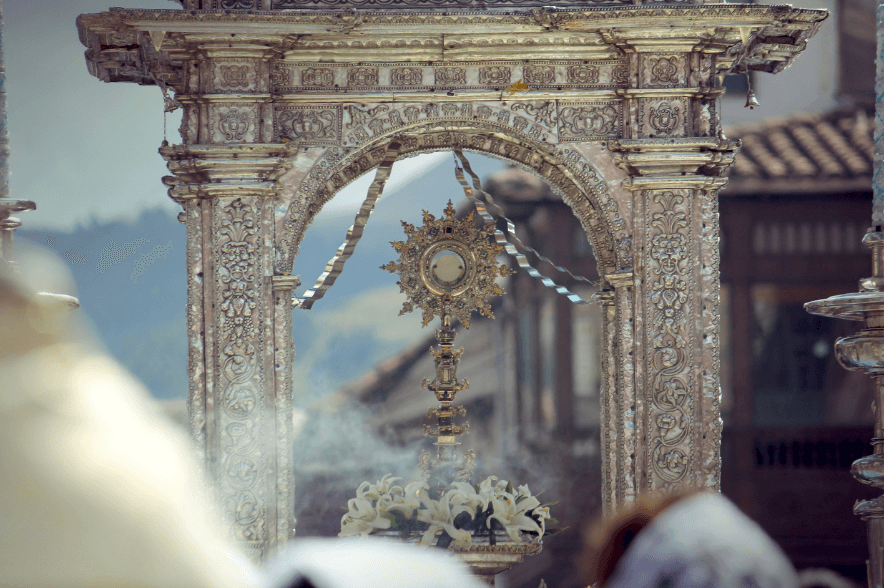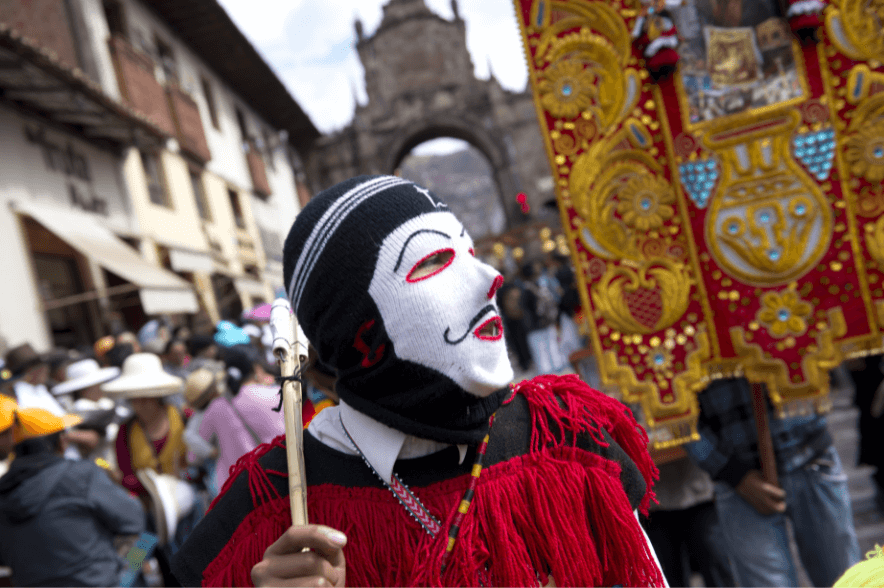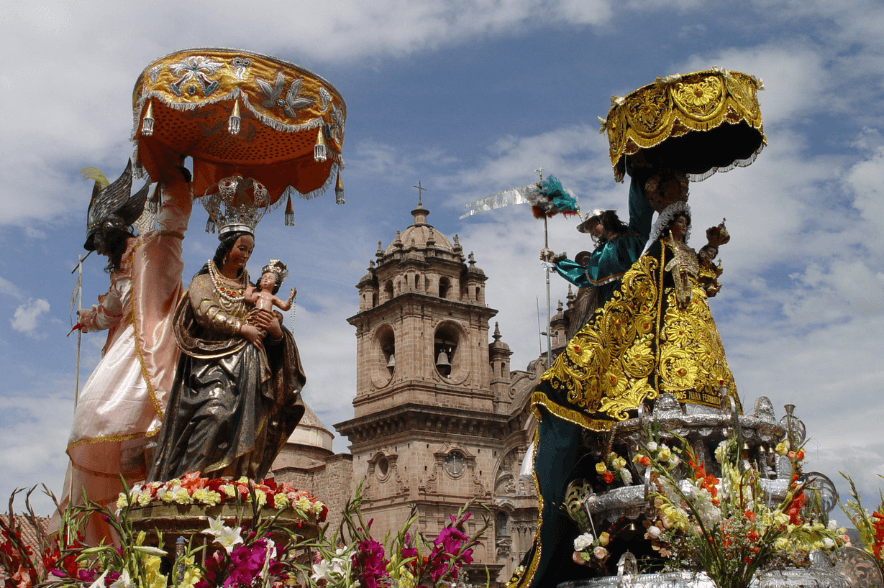Corpus Christi is a very traditional religious celebration in the imperial city of Cusco because it also harbors the customs of several different indigenous peoples in one place and is a beautiful spectacle that amazes visitors as well as the local residents.

Photo 1: Holy Tabernacle in procession for Corpus Christi
History of Corpus Christi
During the time of the Incas, there were many fiestas dedicated to their ancestors and the gods. Among these were the Taita Inti, the goddess Killa, Kuychi, etc., which were very significant to them. Of course, the most important feast of all was the fiesta in honor of the Inti (the Sun) and in ancient times they would carry the mummies of their former rulers in a procession before the big celebration.
The Spaniards were amazed at what they saw and took advantage of the festivity in their process to “evangelize” the people to Christianity. And so, in 1572, they decided to replace the procession of mummies with a procession of the 15 saints and virgins that to this day is known as the Cusquenian Corpus Christi.
When is Corpus Christi held?
Following the church calendar, Corpus Christi is held nine weeks after Maundy Thursday (Holy or Easter Week). This year, in 2022, the festivities will be held on June 16.

Photo 2: Ukuku dancer in Corpus Christi procession
How is Corpus Christi celebrated?
Preparing for the feast of Corpus Christi
We mentioned that this was a very important festivity and so, quite naturally, the organization prior to the feast day is equally important. The hosts, also known as the carguyoq, are in charge of offering the food, beverages and a band of musicians to accompany the followers when the saints are brought out in procession.
Cusqueño food is certainly a highlight, especially in these festivities. The Chiri Uchu is an iconic dish during Corpus Christi and you won’t want to miss it for the world.
Entry of the saints
On the eve of the eucharist celebration of Corpus Christi, the effigy of each of the saints leaves their church or temple, accompanied faithfully by their followers with dances and music typical of each region. One would think they were all close to the main venue of the event, but many come from as far as 10 kilometers away from the main plaza.
The destination of all the saints is the Arco de Santa Clara (St. Claire’s Arch) and then to the church of San Pedro, where you can see the symbolic handing over of the keys to the cathedral by Saint Peter to Saint Anthony. When all the saints are gathered, the procession then continues towards the entry of the cathedral, in which they will spend a whole week until the Octava, the eighth week after Easter.

Photo 3: Procession of various Saints through Corpus Christi
Which are the saints that participate?
- San Antonio from the San Cristóbal Parish
- San Jerónimo from the District Parish of San Jerónimo
- San Cristóbal from the Parish of San Cristóbal
- San Sebastián from the District Parish of San Sebastián
- Santa Bárbara from the District Parish of Poroy
- Santa Ana from the Parish of Santa Ana
- Santiago Apóstol from the Parish of Santiago
- San Blas from the Parish of San Blas
- San Pedro from the Parish of San Pedro
- San José from the Parish of Belén
- Virgen de la Natividad (Our Lady of the Nativity) from the Parish of Almudena
- Virgen de los Remedios (Our Lady of Remedies) from the Church of Santa Catalina
- Virgen Purificada (Holy Virgin) from the Parish of San Pedro
- Virgen de Belén (Our Lady of Bethlehem) from the Parish of Belén
- Virgen de la Inmaculada Concepción (Our Lady of Immaculate Conception) also known as “La Linda” from the Basilica of the Catedral
The Main Feast of Corpus Christi
The celebration of Corpus Christi itself is understood to mean the celebration of the body of Christ at the Eucharist and fidelity to that devotion, and the main event is the mass —which is held in Quechua — with the presence of all the saints.
The event that everyone waits for on that day is the procession of the 15 saints, which are carried to the beat of the festive traditions and the music of innumerable huaynos. The musical arrangements are personalized for the different saints by their followers.
The ceremony generally ends as night falls, when the last effigy has entered the cathedral and each congregation leaves to the rhythm of their dances and to drink until the following day.

Photo 4: Patron San Cristóbal in procession through Corpus Christi
The Octava of Corpus
The Octava is the date on which the procession of the 15 saints takes place around the main plaza in Cusco. The usual time for the events begin is after lunch, around two o’clock in the afternoon, and it ends close to seven o’clock at night.
Lowering the Saints
This usually starts on the day after the Octava and the ‘lowering’ actually means the return of the sacred images to their respective churches (or temples). However, some of the protocols differ, as is the case with Our Lady of Bethlehem.
Words are not enough to describe the fervor and excitement that this fiesta offers. If you have the opportunity to travel to Cusco for these events, don’t think twice and do it. If it was already in your plans and you have the time available, how about a visit to the Citadel of Machu Picchu? The PeruRail Vistadome train has every comfort to make your trip the best experience of all. Buy your tickets here!